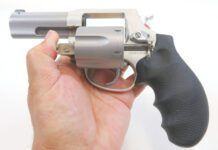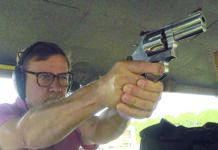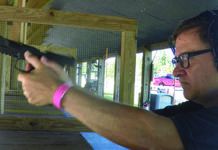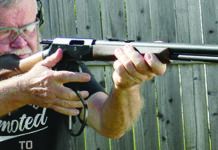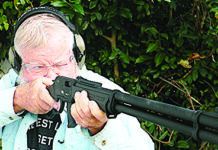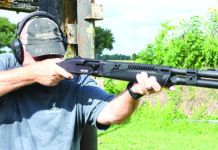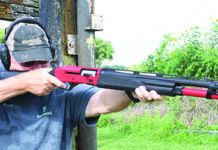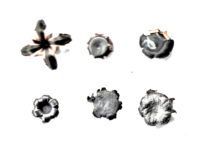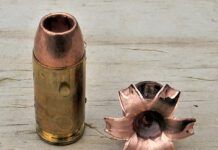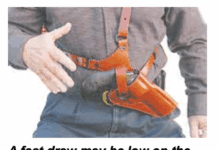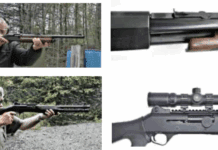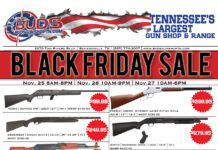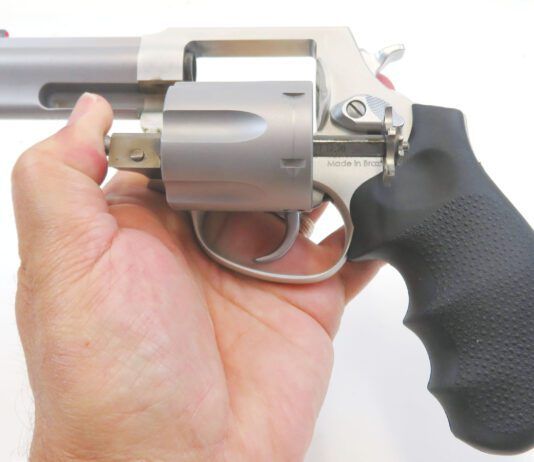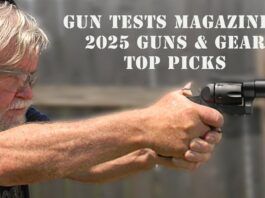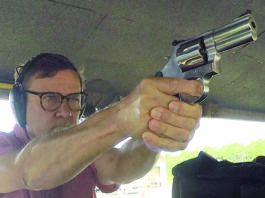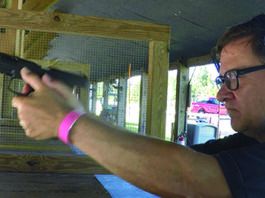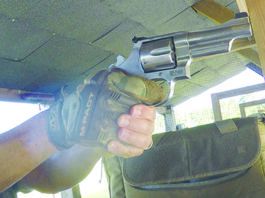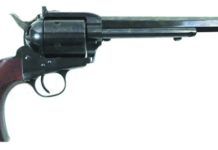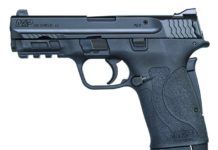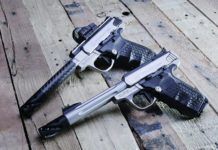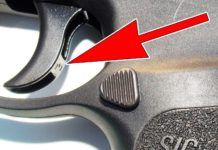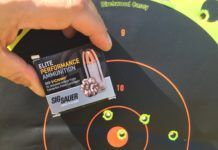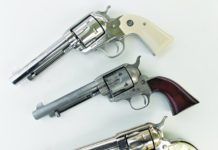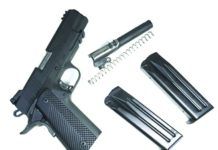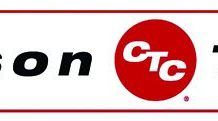Taurus Model 66 38 Sp. +P/357 Magnum, $325
When we began testing the 4-inch 357s, we wondered if a longer barrel, such as the 6-inch Taurus 66 357 Magnum, might give us the best of both worlds. It is a K-frame revolver like the Combat Magnum, but a 6-inch barrel might give us good velocity and accuracy. We were disappointed in its performance. Still, we would have got our money's worth for a modestly priced recreational and home-defense revolver.
Problems with SIGs P320
We recently published a news item that updates our readers on legal troubles the SIG Sauer P320 is encountering. Most recently, the Loudoun Times-Mirror website is reporting that a Loudoun County (Virginia) deputy has filed a lawsuit against SIG Sauer alleging that her fully-holstered P320 duty weapon discharged and sent a bullet into her leg. According to the newspaper's account, the incident occurred this year on Feb. 7, "… when 37-year-old Loudoun County Deputy Marcie Vadnais went to the Northern Virginia Criminal Justice Academy to attend a general instructor course." The Times-Mirror further reported, "In accordance with academy policy, Deputy Vadnais began removing her firearm from her belt when she arrived." According to the lawsuit, as she fed the belt through the holster's first tooth, her SIG Sauer P320 somehow "fired one nine millimeter bullet, which hit her in the upper right thigh."
Big-Bore Single-Action Revolvers From EAA, BFR, and Cimarron
While the 45 Long Colt could be considered big medicine in a single-action revolver, single-action revolvers chambered in 44 Magnum really up the ante. The 44 Magnum is a substantial cartridge, so a substantial and strong revolver is required to fire that round. We took a look at three single-action revolvers chambered in 44 Magnum — the EAA Bounty Hunter, Cimarron's Bad Boy, and the BFR Short Cylinder housed under the Magnum Research (Kahr) name — and found all three of these powerful revolvers had good attributes, managed recoil well without causing carpal-tunnel syndrome, and were accurate.
Prior to testing, we ran range rods down the barrel to check chamber and bore alignment and found everything was in spec on all three revolvers. Because the 44 Special cartridge can be fired in revolvers chambered in 44 Magnum, we tested all three with Hornady's Critical Defense 44 Special ammo loaded with a 165-grain FTX bullet. For 44 Magnum loads, we chose one of our long stand-by rounds from Black Hills loaded with a 240-grain JHP and a newer load from SIG loaded with a 240-grain V-Crown JHP. All rounds provided excellent accuracy. Because the EAA had fixed sights and the BFR and Cimarron had adjustable sights, we leveled the playing field and tested the EAA at 15 yards and the BFR and Cimarron at 25 yards. The sight picture with the adjustable-sight revolvers was far superior than the sight picture with the fixed sights, though the fixed sights of EAA were a modern take on the classic fixed sights. The EAA and BFR were also drilled and tapped to mount a scope.
VALUE GUIDE: Single-Action Revolvers
Log on to Gun-Tests.com to read complete reviews of these products in the designated months. Highly-ranked products from older reviews are often available used at substantial discounts.
380 ACP Shootout: New Models Versus a Time-Tested Veteran
As our ammunition-selling retail sources tell us, 380 ACP pistols are increasingly popular, and because of that interest, new handguns for the chambering are being introduced at a steady pace. While we have serious reservations concerning the stopping potential of the 380 ACP round, there are some loads that are better than others, and we included these in the test program that follows. Regarding the handguns themselves, here we test three, two that are new variants by respected makers and a third that is a veteran name in the 380 ACP field, despite its being marketed for slim guys who often wear tuxedos.
The first of these handguns is the Smith & Wesson M&P 380 Shield EZ 180023, $384, an important step toward offering a handgun that is well suited to those with lowered hand strength and dexterity. The new Shield isn't a micro-compact pistol but is instead a nice-sized 380 that is all about easy shooting. The "EZ" part of the name refers to an easy cocking system Smith & Wesson claims will make the pistol better for those with limited hand strength to fire and use. If it works as advertised, Smith & Wesson will have provided a handgun that fills a real need. In initial handling, we found the Shield is easier to use than a revolver and most double-action-first-shot pistols because the other types may stress the trigger finger of elderly or female shooters. Likewise, double-action-only or striker-fired safe-action pistols may also present a problem with trigger strength with some shooters. For perspective, we also touched upon the Colt 1903, which, surprisingly, has much in common with the Smith & Wesson Military & Police 380 EZ.
Next up is the Springfield Armory 911 Bi-Tone PG9109S, $516. The Springfield 911 (nine-one-one) is a small 380 ACP that is adorned from the factory with night sights and a set of custom-grade grips. The 911 name was chosen for those who may have to be their own first responder. If you get in a tussle, the thinking goes, police are minutes away if you call 9-1-1, while danger is only seconds away. So, carry the Springfield 911 and be ready at the ready. There are four different 911 models. The PG9109 has a black nitride slide and lists for $599 (see page 16). Two models come with Viridian Green Grip Lasers, the PG9109VG with a black nitride, $789; and the PG9109SVG with a brushed stainless-steel slide, also $789. Our test gun, the PG9109S, has a brushed stainless-steel slide and lists for $599.
VALUE GUIDE: 380 ACP Semi-Auto Pistols
Log on to Gun-Tests.com to read complete reviews of these products in the designated months.
Highly-ranked products from older reviews are often available used at substantial discounts.
August 2018 Short Shots: Pistols and Pistol Accessories
Smith & Wesson Corp. has announced four new Performance Center SW22 Victory Target pistols. The Performance Center SW22 Victory Target pistols are chambered in 22 LR and are designed specifically for target shooting competitions. These pistols feature 6-inch target barrels, muzzle brakes, and Tandemkross hiveGrips, and other high-performance features.
More Legal Problems for SIG’s P320
In response to social media rumors questioning the safety of the P320 pistol, a variant of which was selected by the U.S. government as the U.S. Army's Modular Handgun System (MHS), SIG SAUER, Inc. has full confidence in the reliability, durability and safety of its striker-fired handgun platform. There have been zero (0) reported drop-related P320 incidents in the U.S. commercial market, with hundreds of thousands of guns delivered to date.
The Price of Handgun Accuracy: How Much to Pay for 3/4s of an Inch?
Another handgun magazine recently ran an article praising the 25-yard accuracy of a 9mm 1911 Ed Brown CCO pistol ($3,585). It shot 2-inch groups using high performance ammo. Curious about how my used S&W 9mm Shield V1 ($269) with a drop-in stainless-steel barrel ($170) would do, I staged my own comparison test. Using SIG Sauer Elite Performance JHP 124-grain ammo, my Shield shot a 2.75-inch group from the rest. The question I have for you and your readers is this: Is the extra 0.75 inch in accuracy at 25 yards worth the additional $3146?
Single-Action Revolvers: Best Buy Is Ubertis Cattleman 1873
In this installment, we test a trio of revolvers from Uberti, Colt, and Ruger in stainless steel, antique or original finish, and nickel plating. We included a Bisley grip frame and two barrel lengths to give readers a broad range of choices if they're interested in 45 Colt single-action revolvers of the traditional style with fixed sights.
The test handguns were the Uberti 1873 Cattleman Old West No. 355131, a Second Generation Colt Single Action Army 45 Colt, and a Ruger Vaquero Bisley No. 5129. Part of our interest was how the longer barrel of the Colt, at 7.5 inches, compared to the 5.5-inch tubes on the others when drawn from leather. Also, we were curious how the Ruger Bisley performed with some pretty stiff loads when pitted against the standard plow-handled grip frame of the Colt and Uberti. For wheelgun aficionados, the comparison of a Colt Single Action Army (SAA) to any of its derivatives always creates interest, and in this case, there's a 2nd Generation SAA that many seek out ahead of more-modern-production versions.
Cowboy Action shooters are thought to have the most interest in single-action revolvers, but there are many more SAA-type revolvers sold than there are cowboy shooters, even considering that such competitors need two guns in action and often have one in the shop as well. Folks love single-action revolvers for recreational shooting, for hunting, collecting, and even for personal defense. Yep, if you take the National Rifle Association Handguns 101 course, you will see the list of reasons for owning a handgun, and single-action revolvers fit into every niche, including collecting. As an example, one of our raters has a great deal of law-enforcement experience, and the first time he arrested (on personal time) a lawbreaker at gun point, he used a Colt Single Action Army.
With all of these factors in mind, we went on a bargain hunt, checking gun stores, online sources, and pawn shops to find lightly-pistols in good testing condition. We did not wish to pay too much for the Colt, but we knew we would spend more than a thousand dollars because of their scarcity. And we wanted to pay just a percentage of the new price for the other revolvers. To our thinking, $100 is real money, so if we could find a shooter and save that cash, then we'd have a bargain.
For a thorough evaluation, our shooters fired the three revolvers on a general shooting course and then for accuracy from a solid benchrest. On the action course, shooters drew the revolvers from standard belt holsters and fired at targets at 5, 7, and 10 yards. We also fired offhand at 15 yards to test accuracy and handling. The ammunition used in the general firing course was the Black Hills Ammunition 250-grain cowboy load. This loading is designed for low recoil and good accuracy.
When it came to benchrest accuracy, we were able to properly line up the fixed sights and fire three loads. These included the Fiocchi 45 Long Colt 250-grain Cowboy Action, Hornady's 45 Colt 185-grain Critical Defense brand, a personal-defense loading, and the 45 Colt Buffalo Bore 255-grain semi-wadcutter, an outdoors and hunting load. The three single-action revolvers completed the test without any type of problems. Even after firing 50 cartridges, cylinder rotation never slowed. The hammers cocked smoothly, and the trigger action was consistent. The ejector rods worked as designed, and the cylinders rotated smoothly.
Caliber-Conversion Pistols From Rock Island Armory, Glock, SIG
We wanted to take a look at pistols that are capable of centerfire-caliber conversions. A pistol with the ability to train in a more affordable caliber, or have the ability to increase power, speaks to our practical side since multiple pistols in multiple calibers can be expensive. We also like that a shooter is essentially using the same grip, sights, and trigger, so he doesn't have to adapt to a pistol with different grip angle, sights, or trigger weight and pull. We also think having a pistol that can adapt to different calibers means ammo is easier to find for your pistol. With these thoughts in mind, we acquired a SIG Sauer P226 Nitron in 9mm ($1087) and a Caliber X-Change Kit in 357 SIG ($370). The total setup cost $1457. If you own a pistol capable of caliber conversion, then you just need to opt for the caliber-conversion components. The total for the 40 S&W Glock G35 Gen3 ($560), Glockstore Double Diamond 9mm conversion barrel ($160) and Magpul 27-round magazine ($22) set us back $742. The Rock Island Armory (RIA) TCM TAC Ultra MS HC comes from the factory capable of firing both 9mm and the hot-rod 22 TCM round; total cost is $960. Part of our evaluation was to also see how difficult it was to convert between calibers, and we found it was as easy as field-stripping the pistol and dropping in replacement parts. Across the board, we found that no gunsmithing expertise was required, and you can swap back to the factory caliber easily.
For accuracy testing we benched all three pistols in their paired calibers and fired at targets set at 25 yards. We performed speed drills at 10 yards, firing a magazine as fast as we could while still keeping hits in an 8-inch-diameter-or-smaller target. During close range work, we also performed a variety of magazine reloads and tactical reloads. Overall, we found a lot to like with the conversion kits, and in the case of the Glock, you could be firing 9mm out of a 40 S&W Glock for less than $200. The cost of a new Glock pistol in a separate chambering is nearly three times that amount. We also discovered that swapping calibers poses point-of-impact issues with the Glock, but not with the RIA. The SIG, set up with separate slide assemblies and magazines, was the best choice because there were no point-of-impact issues. The RIA had us very happy in 9mm, but in 22 TCM, we had numerous failures to eject 22 TCM cases — a no go, in our opinion. Here are the details.
June 2018 Short Shots: Pistols and Pistol Accessories
Through June 30, 2018, shooters who purchase any new Crimson Trace Laserguard Pro laser sight and light will be eligible to receive a free Crimson CWL-100 Tactical Light. The CWL-100 features an operation pressure pad and corded attachment cap, and it can also be converted into a hand held flashlight with a second provided endcap. The CWL-100 metal attachment bracket is designed to fit most Picatinny or similar accessory rails. To receive the free Crimson Trace CWL-100 tactical light in this offer, purchasers must complete and submit to Crimson Trace the proof of purchase form found at CrimsonTrace.com along with the receipt.


